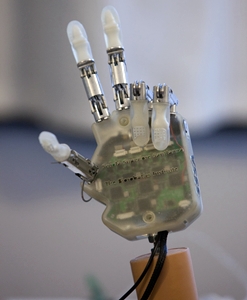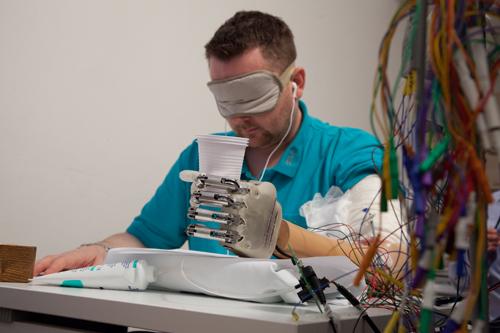5 February 2014. Biomedical engineers and computer scientists at Ecole Polytechnique Federale de Lausanne (EPFL) in Switzerland developed a sensory feedback system for an amputee’s prosthetic hand to control grasping and sense stiffness and shapes of objects. The findings of the Lifehand 2 team led by EPFL’s Silvestro Micera, with colleagues from other institutions in Europe, are published today in the journal Science Translational Medicine (paid subscription required).
Micera and colleagues reported on their work with Dennis Sørensen, a 36-year old man from Denmark, who lost his left hand 10 years ago in a fireworks accident. After the amputation, Sørensen began wearing a commercial prosthetic, which detects muscle movement in his remaining arm, allows opening and closing the prosthetic hand, and holding of objects. However, Sørensen can not feel his grasp, must constantly watch his hold on objects to prevent crushing them.
Lifehand 2 consists of a prosthetic hand with additional sensors, electrodes connected to nerves in Sørensen’s arm, and algorithms translating electrical signals into nerve-like impulses. The sensors added to the prosthetic hand detect the tension in the artificial tendons controlling finger movement, and convert that energy measurement into an electric current. That current, however, is not refined enough to be understood by the human nervous system. Micera’s group devised algorithms to convert the electrical current generated by the sensors, into signals understood by the nervous system.
To capture the signals, surgeons at a Rome hospital in January 2013 implanted four electrodes in Sørensen’s remaining arm that connect to the ulnar and median nerves. The transneural electrodes, made ultra-thin, were designed by colleagues at Freiburg University in Germany, and needed to withstand the formation of scar tissue that developed after the implantation.
After 19 days of preliminary tests, the researchers connected the electrodes to the prosthetic hand. Sørensen then tested the device every day for seven days, under the guidance of Micera’s team. The tests showed Sørensen could control the amount of grasping force exerted through the prosthetic hand, with no visual or auditory feedback, consistently distinguishing between three different force levels.
The tests also showed the enhanced prosthetic hand gives considerably more sensory information about the objects being grasped. In the tests, Sørensen was able to identify the shape and stiffness of three different objects. “I could feel things that I hadn’t been able to feel in over nine years,” says Sørensen in an EPFL statement. “When I held an object, I could feel if it was soft or hard, round or square.”
The study served as a proof-of-concept for the system, but a good deal of work remains before it is ready for the market. Due to restrictions imposed on clinical trials, the researchers had to remove Sørensen’s electrodes after a month, so further tests are needed of the long-term safety and efficacy. In addition, say the researchers, the electronics need to be further miniaturized, with better touch awareness about the angular movement of the fingers on the device.
Read more:
- FDA Approves Spine Compression Fracture Implant Device
- Injectable Therapy for Rotator Cuff Injuries in Development
- Transparent Skull Implant Devised for Laser Brain Treatments
- GSK Starts Venture Fund for Nerve-Signal Devices, Medicines
- FDA OKs Trial of Biopolymer to Treat Spinal Cord Injury
* * *



 RSS - Posts
RSS - Posts
You must be logged in to post a comment.